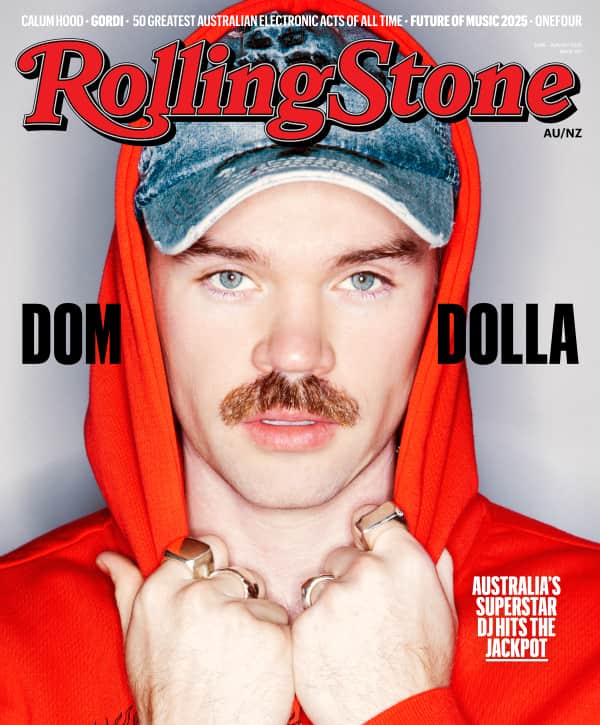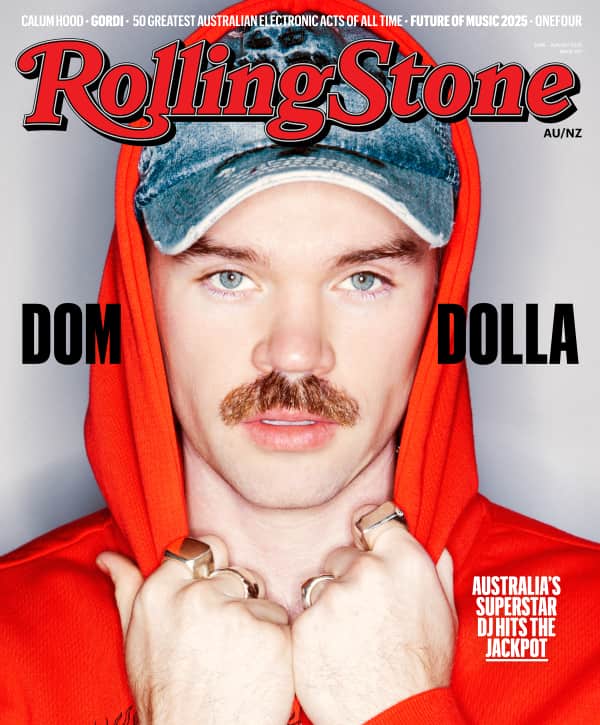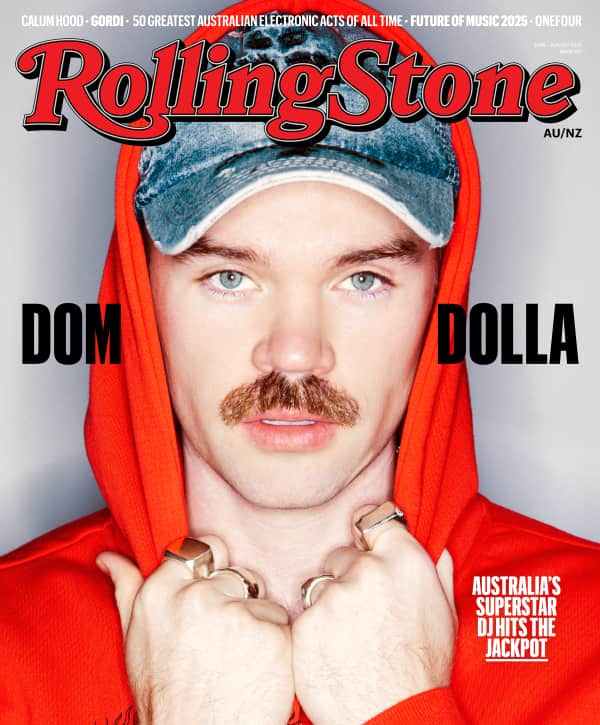By Jon Dolan, Dan Epstein, Reed Fischer, Richard Gehr, Brandon Geist, Kory Grow, Will Hermes, Ryan Reed, Jon Weiderhorn.
For close to a half century, prog has been the breeding ground for rock’s most out-there, outsized and outlandish ideas: Thick-as-a-brick concept albums, an early embrace of synthesisers, overly complicated time signatures, Tolkienesque fantasies, travails from future days and scenes from a memory. Here’s the best of the deliciously decadent genre that the punks failed to kill.
50. Happy the Man, ‘Happy the Man’ (1977)

Formed in a James Madison University dorm room, Washington, D.C.-based Happy the Man recorded three venerated, mostly instrumental prog albums in the late 1970s, striking a seductive middle ground between sax-driven jazz-fusion lunacy (circa Zappa’s One Size Fits All) and synth-heavy meditative twittering. After a showcase, Clive Davis reportedly told the band, “Wow. I don’t really understand this music. It’s way above my head”; yet he still signed them to Arista. Their debut is the band at its most dynamic, highlighted by intricate instrumental interplay as far-out as the song titles (“Stumpy Meets the Firecracker in Stencil Forest,” “Knee Bitten Nymphs in Limbo”). R.R.
49. Ruins, ‘Hyderomastgroningem’ (1995)

Beaming down from the far reaches of the prog-rock galaxy, this Japanese drums and bass duo slam together mathematically improbable meters and dissonant blasts of rhythm with nonsense wails or demonic growls. The band’s fifth album is especially fascinating, as Ruins inject snippets of vocal melody, droning doom, punk tempos, and meticulous Crimson-esque prog into their rapidly morphing songs. The most obvious influence on Ruins’ ringleader Yoshida Tatsuya is Magma’s iconoclastic Christian Vander — like Vander, Yoshida even created his own language for the band — but there are also traces of experimental freaker Frank Zappa and avant-jazz terrorizer John Zorn (who released the album on his Tzadik label). Some have tagged Hyderomastgroningem unlistenable and undoubtedly it could drive most fans of King Crimson or Yes batty. But maybe that just makes Ruins more prog than prog. J.W.
48. FM, ‘Black Noise’ (1977)

Love Music?
Get your daily dose of everything happening in Australian/New Zealand music and globally.
Superficially, Toronto-based FM had a lot working against them: Aside from Rush, Canada was never a prog hotbed, and the band released its debut album in 1977, as many of the genre’s originators were fading. Still, Black Noise was one of late-era prog’s most original albums – a hypnotic blend of symphonic synthesizer effects and glossy New Wave melodies, plus an exotic whirl of electric mandolin and violin from Nash the Slash, a.k.a. Jeff Plewman, who performed onstage with his face entirely obscured by surgical bandages. Opener “Phasors on Stun” became a minor AM radio hit, driven by a yearning hook from frontman-bassist-keyboardist Cameron Hawkins, and the band has released several more albums over the years, but FM never managed to reach their debut’s deep-cosmos magic. “There is a timeless quality about that record,” Hawkins told The Music Express in 2014. R.R.
47. Crack the Sky, ‘Crack the Sky’ (1975)

American rockers aren’t known for their prog ambitions, and the bands that did push the boundaries usually slipped through the commercial cracks. Case in point: West Virginia wise-asses Crack the Sky, who created an outright classic with their kaleidoscopic debut. Led by singer-mastermind John Palumbo, the band expertly navigated chunky hard-rock riffs (“Hold On”), barbed art pop (“Surf City”), fusion funk (the wicked breakdown in “She’s a Dancer”) and long-form balladry (“Sea Epic”). Yet they never achieved more than a faithful regional following, despite a glowing Rolling Stone review: “Like the first albums of Steely Dan, 10cc, and the Tubes, Crack the Sky’s debut introduces a group whose vision of mid-’70s ennui is original, humorous and polished. . .” Bolstered by the fans they do have, Crack the Sky have kept at it: Their 15th studio album, Ostrich, was released in 2012. R.R.
46. Carmen, ‘Fandangos in Space’ (1973)

Flamenco prog: a pretty ridiculous idea, even for 1973. But London-based Carmen made that synthesis feel revolutionary on their debut LP, chasing the vision of Los Angeles singer-guitarist David Allen (who was assisted by his sister and keyboardist Angela Allen). In a glammy yelp, the frontman sang tales of bullfights and gypsies, as the music blended Mellotron, rock rhythms, and zapateado footwork into a cosmic headfuck (produced by David Bowie collaborator Tony Visconti). But it couldn’t last. After releasing two more albums (and opening for Santana and Jethro Tull), Carmen folded in 1975. Even asFandangos in Space has faded into obscurity, it has reached a new generation of musicians. “It’s amazing,” Opeth frontman Mikael Akerfeldt told Metal Hammer in 2012. “It’s a crazy flamenco prog-rock folk record! They had tap dancing on the record and castanets too! Everyone I’ve played it to has been blown away by it.” R.R.
45. Triumvirat, ‘Illusions on a Double Dimple’ (1974)

This German trio is often branded as a clone of Emerson, Lake and Palmer, which is an unfair, if understandable, dismissal. Propelled by Jürgen Fritz’s keyboard arsenal of grand piano, Hammond organ and Moog synth, the band were clearly versed in the science of Brain Salad Surgery. But what they lacked in originality they made up for with mind-boggling chops. Triumvirat’s second LP, 1974’s Illusions on a Double Dimple, is a prog-rock masterwork, incorporating operatic choirs and bursts of pop levity into two seamless, side-spanning epics. They softened their approach later in the decade in a quest for commercial stability — and failed miserably. But thanks to Illusions, Triumvirat’s legacy among the prog firmament was secure. R.R.
44. Strawbs, ‘Hero and Heroine’ (1974)

Led by the ambitious prose and untamed warble of mastermind Dave Cousins, Strawbs started as a bluegrass outfit called the Strawberry Hill Boys, briefly worked with future Fairport Convention singer Sandy Denny, and eventually evolved into full-fledged prog by the mid-1970s. Hero and Heroine is the band’s heaviest, most symphonic album, anchored by John Hawken’s ghostly Mellotron and guitarist Dave Lambert’s stinging distortion. Strawbs hadn’t abandoned their acoustic side — “Midnight Sun” is one of Cousins’ most assured ballads. But the newfound muscle and energy broadened their appeal: Multi-part opener “Autumn” is the band’s most majestic moment, a melancholy epic for the prog time capsule. Bonus fact: Production team Sid Roams sampled the title track for rapper Papoose’s 2008 track “Bang Bang.” R.R.
43. Electric Light Orchestra, ‘Eldorado’ (1974)

Sub-titled A Symphony by the Electric Light Orchestra, ELO’s fourth studio LP was its first to feature an actual orchestra, as opposed to just overdubbed string parts. A concept album about the lonely, romantic daydreams of a man desperate to escape the drudgery of his daily life, Eldorado weaves its songs into a dense, atmospheric tapestry that is essentially pop-prog. Despite some typically brilliant Jeff Lynne hooks – “Can’t Get It Out of My Head,” the band’s first Top 10 hit, was as catchy as its title suggested – the album was meant to be enjoyed as a complete work. Called “something of a triumph” by Rolling Stoneat the time, Eldorado was later used by experimental filmmaker Kenneth Anger as the soundtrack to the 1978 re-release of his surreal 1954 film Inauguration of the Pleasure Dome, which certainly speaks to the album’s transportive, cinematic qualities. D.E.
42. Meshuggah, ‘Destroy Erase Improve’ (1995)

It’s one of those grandiose album titles, like Ornette Coleman’s The Shape of Jazz to Come, which actually lived up to its billing. The Swedish juggernaut’s definitive second album did destroy, erase and improve the prog-metal archetype when it dropped in 1995. Some dubbed the record’s mix of brain-frying polyrhythms, stuttering riffs and Frippian solos “math metal”; the kids called it “djent.” Onomatopoeia for their downtuned and hyper-distorted guitar chug, the term was originally coined by the band’s lead shredder Fredrik Thordendal, and has come to represent a generation of young progressive headbangers like Periphery, Animals as Leaders and TesseracT. But try as they might, none will ever write a song as abrasive yet brainy yet catchy as “Future Breed Machine” — by the band’s own admission, they are the three most repeated words at any Meshuggah concert. B.G.
41. Amon Düül II, ‘Yeti’ (1970)

Described by Lester Bangs in Rolling Stone as “Germany’s great psyche-overload band,” Amon Düül II delivered some serious mind-fry on their sprawling second album. Heavier and hairier than most of their Krautrock contemporaries, the band melded elements of the Velvet Underground, Jimi Hendrix, Frank Zappa, Jefferson Airplane, Pink Floyd and Quicksilver Messenger Service with African, Asian and Indian influences to create something deeply personal and even more deeply weird. Half of Yeti was completely improvised in the studio, but it’s hard to identify which half; pre-written tracks like the opening suite “Soap Shop Rock” and the searing rocker “Archangel Thunderbird” seem to follow their own primal internal compass, while the improvised nine-minute closer “Sandoz in the Rain” (allegedly recorded while the entire band was on acid) is ravishing in its stark, crystalline beauty. Yeti isn’t just one of Krautrock’s greatest albums; it’s one of the finest records of the entire original psychedelic era. D.E.
40. The Soft Machine, ‘Third’ (1970)

To quote Robert Wyatt’s lyrics from Third‘s “Moon in June,” Soft Machine specialized in “background noise for people scheming, seducing, revolting and teaching.” Cosmically heady, unconventional to a fault, and often more audibly jarring than a piano dropped on top of a piano, the English instrumental savants’ unvarnished tape collages make Pink Floyd songs sound like bubblegum. With four compositions nearly 20 minutes each, Third opens with the free-jazz menace of “Facelift,” which is even more out-bloody-rageous than the cool-ambient freakout of “Out-Bloody-Rageous.” Keyboardist Mike Ratledge spent the entire album going typically nuts. While Wyatt spoke in tongues, he and bassist Hugh Hopper made the aforementioned “June” sound like six Cream songs played simultaneously. “I work in a trance, don’t really know what I’m doing ’til it’s done,” Wyatt has said. R.F.
39. Porcupine Tree, ‘Fear of a Blank Planet’ (2007)

For their ninth studio recording, British art-rockers Porcupine Tree created a concept album based on the Bret Easton Ellis novel Lunar Park, with lyrics that addressed how the adolescent protagonist battled his bipolar and attention-deficit disorders with a regimen of prescription drugs and Internet overstimulation. The music used sprawling vocal melodies, atmospheric guitars and drums that tumbled through chaotic passages to echo the main character’s manic-depressive states. Porcupine color their songs with chiming prog, serrated Nineties alt-rock and blaring hard-rock power chords, enlisting the help of Robert Fripp, Rush guitarist Alex Lifeson and ex-Japan keyboardist Richard Barbieri. J.W.
38. Gong, ‘You’ (1974)

Australian ex-pat Daevid Allen is one of prog’s greatest weirdos: He co-founded genre pioneers Soft Machine, then triangulated psychedelic English whimsy, German kosmische space jams and Gallic libertine fusion in French-British outfit Gong. His magnum opus, serialized across three LPs known as the Radio Gnome Trilogy, was an appropriately gnomic narrative involving pothead pixies, octave doctors, flying teapots and a journeyman known as Zero the Hero. The music was even wilder, and You, the trilogy’s finale, was its pinnacle. While Allen swapped pronouncements with muse Gilli Smyth — Nico reimagined as a soft-porn Glinda the Good Witch — alongside Didier Malherbe’s free jazz windstorms and Steve Hillage’s ‘shrooming John McLaughlin freakouts, the group created a cartoon hash-den passion play as hilarious as it was semi-profound. W.H.
37. Marillion, ‘Clutching at Straws’ (1987)

British prog-rock darlings of the Eighties, Marillion took the spirit of Peter Gabriel-fronted Genesis and reworked it for an American rock audience that was chaps-deep in hair metal. Following up 1985 commercial breakthrough Misplaced Childhood — which stayed at Number One on the U.K. album charts and went to Number 47 in the U.S. — Marillion’s fourth album balanced melody and melodrama. Surrounded by atmospheric production and guitarist Steve Rothery’s spacious, relatively restrained guitar (which split the difference between Genesis’ Steve Hackett and U2’s the Edge), Fish unspooled a poignant, almost spoken-word tale about a loser musician and deadbeat dad who drinks away his pain in pubs, hotel rooms and venues. “The concept was maybe too close to home,” he wrote in the liner notes for the album’s 1999 re-release. Fish soon left the band to recover and pursue a solo career. J.W.
36. Harmonium, ‘Si On Avait Besoin D’Une Cinquieme’ (1975)

For their second record, French-Canadian folk guitar trio Harmonium expanded into a symphonic quintet, adding woodwinds and keyboards to flesh out a concept album based on the four seasons (and a fantastical fifth). The first side is all pastoral warmth, with guitarist Serge Fiori’s sweet-nothings croon, and jazzy asides. Elegant stuff, but only a warm-up for the side-two centerpiece “Histoires sans paroles,” which is 17 minutes of cyclical flute themes, Mellotron haze, and billowing vocal harmonies (featuring guest Judi Richards). In 2007, journalist Bob Mersereau ranked Si On Avait Number 56 in his book The Top 100 Canadian Albums. But he may have undersold the album — it’s the pinnacle of the entire folk-prog movement. R.R.
35. Banco Del Mutuo Soccorso, ‘Io Sono Nato Libero’ (1973)

Prog flourished in Britain, but some of the genre’s most innovative bands (PFM, Le Orme, Goblin) came from Italy. Banco were the most unique of the bunch, defined by the operatic bellow of Francesco Di Giacomo and the expressive dual keyboards of brothers Vittorio and Gianni Nocenzi. While 1972’sDarwin! showcased the sextet’s Romantic edge, the following year’s Io Sono Nato Libero (or I Was Born Free) perfected the approach with cleaner production and refined arrangements. From the serene ballad “Non Mi Rompete” to the 15-minute symphonic-rock pummeling of “Canto Nomade per un Prigioniero Politico,” the album represents Rock Progressivo Italiano at its purest. R.R.
34. Caravan, ‘In the Land of Grey and Pink’ (1971)

Among the many memorable bands to emerge from Canterbury, England — including the Soft Machine, Gong and Camel — none conveyed the southeastern cathedral town’s pastoral qualities better than Caravan. The title and cover art of the quartet’s third album evoked a Middle Earth sunset, with the music wavering between medieval folk melodies and jazz-savvy musos rocking out over what bassist Richard Sinclair called “a load of words that half mean something.” Side one consisted of short, charming songs like “Golf Girl,” the Tolkien-y “Winter Wine” and the surreal Boy Scout ramble of the title track; but side two was solely devoted to “Nine Feet Underground,” a 22-minute, eight-part suite with Zappa-esque subtitles — e.g., “Dance of the Seven Paper Hankies” — that unfurled a breezily grooving descent into hell and back dominated by extended fuzz-organ solos. R.G.
33. Tool, ‘Lateralus’ (2001)

By the release of Tool’s third album, the band had moved far past sub-three-minute songs with in-your-face lyrics, like 1992’s anti-censorship quick hit “Hush.” By contrast, Lateralus‘ nine-and-a-half-minute title track is based, both in its time signatures and lyric patterns, on the Fibonacci sequence of numbers that describes many of nature’s spiraling shapes, from ferns to pine cones. Despite its musical complexity, abstruse themes and embrace of the band’s King Crimson fandom, the album debuted at Number One and launched Tool into amphitheaters and arenas around the world. “Most bands have been taught that they have to write these formulaic pop songs to be successful,” guitarist Adam Jones told Guitar World at the time. “As soon as you start listening to those rules, you’re in trouble.” B.G.
32. Kansas, ‘Leftoverture’ (1976)

Europe may have been the epicenter of progressive rock during the 1970s, but prog was certainly thriving in the American heartland as well. Influenced by Yes and Genesis, but also boasting serious Southern Rock fire and swing, Kansas’ fourth album sold more than five million copies, largely on the strength of its bong-rattling opener “Carry On Wayward Son.” But there was more to Leftoverture than a classic-rock staple; tracks like “Miracles Out of Nowhere,” “Cheyenne Anthem” and the six-part mostly instrumental “Magnum Opus” (first movement: “Father Padilla Meets the Perfect Gnat”) showcased the unique sound and vision of a legit arena-rock act. In his Rolling Stone review, Alan Neister wrote: “Leftoverture warrants Kansas a spot right alongside Boston and Styx as one of the fresh new American bands.” D.E.
31. Renaissance, ‘Ashes Are Burning’ (1973)

With a debt to psych-pop outfits Jefferson Airplane and It’s a Beautiful Day, plus English folk-rockers like Fairport Convention and Steeleye Span, Renaissance’s Annie Haslam brought a feminine energy to prog rock’s sausage fest: See the title track, the band’s signature, which she ends with a spectacularly held note that Geddy Lee couldn’t hit if his balls were in a panini press. Formed from the ashes of the Yardbirds by Keith Relf and Jim McCarty, the band went through radical personnel changes over the years, all in service of meshing classical, folk and rock, but with more of a traditional song-sense than most of their prog peers. This set split the difference between hooks and sprawl. And 40 years later, Annie Haslam is still spinning tales like Guinevere. W.H.
30. U.K., ‘U.K.’ (1978)

Prog disciples looked to U.K. as one of the most promising supergroups ever — the band featured ex-members of King Crimson, Yes, Roxy Music and Soft Machine. But they only stuck around for about three years, creating an intensely melodic blend of prog and jazz fusion on their debut, achieving orchestral intricacy without drifting off into self-indulgence. Eddie Jobson’s twirly keyboards and weepy electric violin duel playfully with Allan Holdsworth’s soaring guitar, while John Wetton’s resounding bass locks in with Bill Bruford’s syncopated drumming. After the album was released, Bruford and Holdsworth bolted, expressing disinterest in working on a more elaborate follow-up. “The theory was that America needs a new ELP,” explained Bruford at the time. “Half of U.K. [felt that way], and me and Holdsworth thought that America needed Holdsworth.” The remaining members never quite captured the debut’s groove and broke up in 1980 — though Wetton and Jobson reunited in 2012 to tour. J.W.
29. Dream Theater, ‘Metropolis 2: Scenes From a Memory’ (1999)

For those who wish Rush was still stuck in 2112, Dream Theater have been a welcome alternative for decades, but this is their most impressive display of intricate, concept-metal proggery. Inspired by nine-minute-plus 1992 track “Metropolis Part 1: The Miracle and the Sleeper,” Dream Theater reached their peak moment of high drama by extending the song’s original story line about a woman who dies and the man who may have killed her. A two-act, 80-minute, non-linear production, Metropolis Pt. 2: Scenes From a Memory is composed of nine songs that delve into the murder mystery by exploring a new character’s past-life regressions and paranormal experiences. To supplement the rather bewildering story, the band weaves together epic instrumental flourishes influenced by early Rush, Fates Warning and Queensrÿche. Guitarist John Petrucci wrote on his Web site, “We’d always wanted to do a concept album, so we figured, why not?” J.W.
28. Opeth, ‘Blackwater Park’ (2001)

Titled in tribute to the early-Seventies German proggers of the same name, Blackwater Park marked the first time these Swedish death-metal virtuosos gave full reign to the progressive tendencies that had long lurked in their music. With Porcupine Tree’s Steven Wilson producing plus adding keyboards, Mellotron and backing vocals to epic, multi-movement excursions like “The Drapery Falls,” “Leper Affinity” and the misanthropic 12-minute title-track climax, Opeth leader Mikael Åkerfeldt infused the melodic, atmospheric aspects of King Crimson and Pink Floyd with Opeth’s complex, dark riffs and his own sepulchral growl. “I would not call it melancholy, it’s just pitch black!” Åkerfeldt told Ultimate Metal. “Everything is kind of veiled in some kind of darkness.” Wilson assisted on two other similarly brilliant albums — 2002’s Deliverance and 2003’s Damnation — but Blackwater Park marked Opeth’s ascension to metal’s top tier. D.E.
27. Supertramp, ‘Crime of the Century’ (1974)

Following two flops, the band famously financed by a Dutch millionaire throttled down their progressive ambitions for an album of tighter, poppier songs. It sold more than 20 million copies, delivering the hits “Bloody Well Might” and “Dreamer,” while breaking Supertramp in the United States. Like Pink Floyd without Roger Waters’ arrogance, Crime focused on adolescent angst (“Hide in Your Shell”), adult alienation (“Rudy”) and madness (“Asylum”). Unfortunately for Supertramp’s two songwriters — the emotionally exposed Roger Hodgson and the more rocking Rick Davies – Crime was the last time the pair were on the same page. Thus, according to Hodgson, the album represents “the pinnacle of the band being together as a unified entity.” R.G.
26. Van Der Graaf Generator, ‘Pawn Hearts’ (1971)

The third album by Van Der Graaf Generator won over prog fans by featuring King Crimson guitarist Robert Fripp. But Pawn Hearts turned out to be a confusingly heady trip for even the most attentive listeners. On “Man-Eng,” singer/idea machine Peter Hammill showed off his operatic chops over processional keyboards and rollercoaster drums, then yowled, “How I can be free!” during a stampeding middle section that evolves into six minutes of kiting sax and keyboard abstraction. And the 23-minute “A Plague of Lighthouse Keepers (Medley)” makes King Crimson sound like the Ramones, with its gaping, spacey interludes, freeblown solos, jarring shifts, and lyrics like, “When you see the skeletons of sailing-ship spars sinking low/You’ll begin to wonder if the points of all the ancient myths are solemnly directed straight at you.” These guys tried to channel all the myths at once, making for music that was pure prog id, minus any cohesion or concision to hamstring the majesty. J.D.
25. The Mars Volta, ‘De-Loused in the Comatorium’ (2003)

“Our music demands. . .at least an hour out of your life, and with complete silence and with complete devotion,” Mars Volta vocalist Cedric Bixler-Zavala once proclaimed. Even a semi-monastic hour (and 51 seconds) of listening reveals a satisfyingly twisted universe within these Texas oddballs’ first full-length suite, De-Loused in the Comatorium. Emerging from the vitriolic ashes of Bixler-Zavala and virtuoso guitarist Omar Rodríguez-López’s art-punk project At the Drive-In, the group manically aligns triumphant metal, psychedelic rock and Latin jazz. The oft-grotesque lyrics — about a man who overdoses on morphine and rat poison and goes into a coma — are repeatedly ruptured and stitched back together with a desperate flair by Rodríguez-López. Produced with Rick Rubin, De-Loused also featured low-end rumbles from stand-in bassist Flea and drumkit pyro from current Queens of the Stone Age stickman Jon Theodore. The 12-and-a-half minutes of “Cicatriz E.S.P.” — complete with a helicopter interlude — show 21st Century prog’s heartbeat to be as irregular as ever. R.F.
24. Magma, ‘Mëkanïk Dëstruktïẁ Kömmandöh’ (1973)

With Magma, French drummer-composer Christian Vander literally created a new musical language — “Kobaïan,” named after a planet he also invented — melding manic opera, Coltrane-influenced free jazz, thunderous avant-rock, and extra-terrestrial lyrical themes into a self-styled genre known as “zeuhl.” Vander perfected his particular brand of insanity on Magma’s third LP, a barrage of choral shrieks and tricky time signatures that ranked Number 33 on Rolling Stone France‘s 100 Greatest French Rock Albums. Mekanik‘s expansive explorations are basically “prog” at its purest, pushing conventional rock structures into strange new territories. But Vander rejects any such definition. “‘Zeuhl’ music means ‘vibratory music,'” he told The Big Takeover this year. “It is definitely not a subset of prog, and Magma isn’t a prog group. Magma is an institution.” R.R.
23. Tangerine Dream, ‘Phaedra’ (1974)

German experimentalists Tangerine Dream gravitated towards a more structured approach to composition on this early masterpiece of progressive electronic music; it was a tactic necessitated by the group’s recent acquisition of a Moog sequencer, which took several hours a day just to tune properly. ThoughPhaedra was recorded under extremely trying circumstances (“Technically, everything that could go wrong did go wrong,” TD founder Edgar Froese later recalled), the results were stunning, especially the 17-minute headtrip title cut, which layered an accidentally recorded Moog synth track with flute, Mellotron, bass sequencer and white noise — an additional sense of interstellar drift was created by the Moog’s oscillators, which lost their tuning as the machine heated up. Challenging, otherworldly and almost indescribably beautiful, Phaedra exerted a massive influence on ambient and electronic artists for decades after its release. D.E.
22. Rush, ‘2112’ (1976)

Few things are more archetypally “prog” than the side-long title cut of Rush’s fourth album. A 20-minute, seven-part suite, “2112” takes place in an Orwellian dystopia where rocking is forbidden — which is ironic, of course, considering how hard the track rocks. The album’s second side is broken into five distinct songs (highlighted by the “Dude, we totally smoke dope!” travelogue of “A Passage to Bangkok”); but the first side’s enduring power is such that the album still would’ve gone multi-platinum if nothing had followed but narwhal mating calls. Recorded at a critical juncture in Rush’s career (their previous album had stalled at Number 60 on the Canadian charts!), 2112 was the Toronto power trio’s first classic release; it was also a ringing affirmation of their commercial potential, despite drummer Neil Peart’s labyrithnine rhythms and Geddy Lee’s distinctive voice. D.E.
21. Camel, ‘Mirage’ (1974)

The classic Camel lineup occupied a unique niche in progressive rock, specializing in fluid, spacey ensemble workouts – rarely as flashy as Genesis, never as bombastic as Emerson Lake and Palmer. “We’re considered a progressive band, by default, really,” guitarist-flautist Andy Latimer told Will Romano for his 2010 book Mountains Come Out of the Sky: The Illustrated History of Prog Rock. “I always thought that people like Yes and King Crimson and ELP were much more obscure than Camel. They were probably better players and consequently got into much more complicated material, which made it even. . . less accessible.” The quartet’s second album, Mirage, fulfills their debut’s scattered promise, with Latimer and keyboardist Pete Bardens leading the rhythm section through breezy instrumentals (the contemplative “Supertwister”) and expansive multi-part suites (the Lord of the Rings–themed “Nimrodel/The Procession/The White Rider”). R.R.
20. King Crimson, ‘Larks’ Tongues in Aspic’ (1973)

With his third lineup in four years, King Crimson guitar maestro Robert Fripp finally tapped back into a musical energy as powerful and groundbreaking as that of his 1969 debut In the Court of the Crimson King. The group’s fifth album was a masterful mélange of painstaking composition and wild experimentation, as if Fripp were depicting a madman struck with glimmers of melancholy clarity. In the end, it’s difficult to tell which passages were happy accidents and which were carefully constructed; and it’s even harder to determine which are more impactful, as clattering trays, chiming bells, twittering birds, understated voices and clown-toy laughter intertwine with tinny, static-filled guitar, epileptic beats and violin lines that range from gorgeous to harrowing. J.W.
19. PFM, ‘Per un Amico’ (1972)

With their definitive second album, Premiata Forneria Marconi pushed Italian prog into the international spotlight. Like fellow countrymen Banco, the band approached the popular British symphonic style with a Romantic flair, Mauro Pagani’s flute and violin adding an ethereal element to the simmering title track and the shape-shifting “Appena Un Po.” Discovered by Emerson, Lake and Palmer during an Italian tour, PFM signed to ELP’s Manticore Records, which released 1973’s Photos of Ghosts, a version of Amico that was remixed and modified with new English lyrics by King Crimson’s Peter Sinfield. (The album even cracked the Billboard album chart at Number 180). “PFM never played a style of rock music that pretended to be Anglo-Saxon,” drummer-vocalist Franz Di Cioccio said in the liner notes to the Photos of Ghosts reissue. “We always defended our own style of music and our own roots.” R.R.
18. Frank Zappa and the Mothers of Invention, ‘One Size Fits All’ (1975)

Before Frank Zappa released One Size Fits All, he bragged to reporters, “You could actually dance to this record.” Consider the source. Although the album certainly rocks (occasionally), it also brims with the jazz and prog benchmarks of Zappa’s career: goofy time shifts, squeaky keyboards (by George Duke), atypical rock instrumentation (fretless guitar, marimba, flute, vibraphone) and far-out lyrics like, “‘Arf,’ she said.” Wild jams such as “Po-Jama People” and the shimmery, stuttering “Andy” are the pinnacle of Zappa’s art-rock experimentalism, while the herky-jerky “Inca Roads” contains one of the main Mother’s most jaw-dropping guitar solos. Future Zappa “stunt guitarist” Steve Vai called hearing One Size Fits All a turning point in his life, referring to “Inca Roads” as an “unprecedented masterpiece” in 2011. “[It] gave me a new reason to live,” he said. K.G.
17. Mike Oldfield, ‘Tubular Bells’ (1973)

The opening sequence of Tubular Bells is most widely known as The Exorcist‘s foreboding theme, but many of this album’s freakiest moments come much later. Recorded by 19-year-old English prodigy Mike Oldfield, two 20-minute-plus sections play out variations on almost every theme that could form in the head of a young LSD voyager. “We wouldn’t have all those beautiful tracks like ‘Lucy in the Sky With Diamonds,’ and we probably wouldn’t have Tubular Bells — a lot of things, really — without drugs,” Oldfield later told The Guardian. The first half employs ambient soundscapes, guitar riffage and a section where “master of ceremonies” Vivian Stanshall mock-pretentiously introduces an array of instruments — “glockenspiel!” and “two slightly. . .distorted guitars” — à la the Bonzo Dog Band. In part two, Oldfield totally loses his shit, as phlegmy, drunken grunts and howls over otherwise upbeat symphonic rock leads into “The Sailor’s Hornpipe,” better known as the seafaring song popularly used in Popeye cartoons. R.F.
16. Gentle Giant, ‘Octopus’ (1972)

Baroque counterpoint harmonies, medieval recorder passages, funk rhythms, hard-rock hooks – British experimentalists Gentle Giant mastered this bizarre formula on their fourth album, Octopus, which marked the end of one era for the band and the beginning of another. It was the swan-song for multi-instrumentalist Phil Shulman and the debut for drummer John Weathers, the grooviest percussionist in all of prog, and Giant leave no weird musical stone unturned (check the complex madrigal vocal parts of “Knots”). Still, their mad-scientist experiments were balanced by the raw rock majesty of classics like “The Advent of Panurge.” “I think that this album was the culmination of what and where the band was headed into the rest of the decade,” frontman Derek Shulman said in the LP reissue’s liner notes. R.R.
15. King Crimson, ‘Red’ (1974)

Like most of their fellow prog-rockers, King Crimson began as a crew of English pastoral fantasia-slingers, though more schizoid than most. By Red, with the Sixties little more than a bad hangover, guitar guru Robert Fripp had distilled his approach down to a trio playing the most bone-crunchingly heavy music prog had yet heard. The sound of his serrated guitar abstractions slashing through Bill Bruford’s beat jungles and John Wetton’s low-end theorizing defined the idea of a power trio, and it’s not hard to imagine, per legend, that Kurt Cobain dug this record and took notes. Ultimately, the intensity imploded; Fripp broke up the band soon thereafter, following a spiritual path, before reforming it with Bruford years later. But it was never as powerful as this. W.H.
14. Genesis, ‘Foxtrot’ (1972)

Arguably the first great Genesis album, Foxtrot took the eccentric worldview and symphonic grandiosity of 1971’s Nursery Cryme and upped the ante with more consistent songwriting and a tougher musical attack. It also added two prog-rock classics to the Genesis canon: the UFO-via-Mellotron fantasy “Watcher of the Skies,” which gave the album a bracingly powerful opener, and the 23-minute closer “Supper’s Ready,’ which would become a highlight of Genesis live sets for years to come. Partly inspired by some unsettling supernatural events experienced by frontman Peter Gabriel, the stunning seven-movement suite offered up heavy doses of Biblical and Greek mythological imagery, some of the band’s most adventurous playing and the use of several unusual time signatures, such as the roaring self-explanatory section “Apocalypse in 9/8.” D.E.
13. Pink Floyd, ‘Animals’ (1977)

Loosely based on George Orwell’s book Animal Farm, Roger Waters’ third consecutive concept album replaced Orwell’s critique of Stalinism with a scathing indictment of capitalist oppression during Margaret Thatcher’s term as England’s prime minister. The band derided by punks like the Sex Pistols as epitomizing “dinosaur” rock performed thick, rich protest music here, with some of David Gilmour’s most glorious blues playing amid bleak panoramas of processed sound. Consisting of three long tracks bookended by the gently acoustic “Pigs on a Wing,” Animals was the first album Pink Floyd recorded in its own studio. R.G.
12. Emerson, Lake and Palmer, ‘Brain Salad Surgery’ (1973)

For prog-rock excess, this power trio took the cake and serving platter: Keith Emerson’s keyboard showroom; Carl Palmer’s motorized, rotating behemoth drum kit; sports-arena gigs with full orchestra and choir, etc. But here, they masterfully balanced the bombast and brilliance. Brain Salad Surgery opens in full-tilt English-poetic-visionary style with a soaring arrangement of William Blake’s “Jerusalem.” It then moves through funky baroque folk-rock (“Still. . . You Turn Me On”), Emerson’s virtuoso riff on a piano concerto by 20th Century Argentine composer Alberto Ginastera (“Toccata”) and the nearly half-hour-long, multi-part dystopian fantasy “Karn Evil 9,” in which intoxicating entertainments (a sideshow where a “Gypsy queen/In a glaze of Vaseline/Will perform on a guillotine”) distract us from evil computer intelligence and modern surveillance-era Interwebs. Prescient and pretty damn rocking. W.H.
11. Rush, ‘Hemispheres’ (1978)

Rush moved away from multi-part conceptual pieces in the Eighties, but the trio unleashed two more great ones before the Seventies ended. “Cygnus X-1 Book II: Hemispheres” (the sequel, of course, to “Cygnus X-1 Book I: The Voyage,” which ended 1977’s A Farewell to Kings) led off Hemispheres with 18 minutes of mythological allegory set to air-drumming-worthy changes, while “La Villa Strangiato” concluded the record with a complex nine-minute instrumental based on a surreal dream experienced by guitarist Alex Lifeson. Lying in between were “Circumstances” and “The Trees,” both of which pointed the way to the shorter, sharper — yet still philosophical — power-chord blasts that the band would deliver in the coming decade. “Everything that went into the making of that record came in a difficult way,” Geddy Lee said years later. “The material was ambitious.” D.E.
10. Yes, ‘Fragile’ (1971)

Pop radio had never heard anything like “Roundabout,” Yes’ mind-bogglingly unlikely breakout single. Built on Steve Howe’s kaleidoscope of classical acoustic and electric guitars, Rick Wakeman’s Jan-Hammer-in-an-Anglican-church organs and Bill Bruford’s wild-ass polyvalent drumming (especially the galloping, bonkers midsection), it reached Number 13 on the Billboard charts and, along with the album, went on to become a classic rock staple, shaping generations of ambitious rockers. “When I was 7 years old I found Fragile in my dad’s record collection,” said Red Hot Chili Peppers guitarist John Frusciante, who considered Howe his favorite guitarist. “I would put the record on and watch the living room turn into a womblike, cozy place. Their music was so magical and seemed almost unreal.” W.H.
9. Genesis, ‘The Lamb Lies Down on Broadway’ (1974)

One of rock’s more elaborate, beguiling and strangely rewarding concept albums, this double-vinyl classic stars the ever-theatrical Peter Gabriel as Rael, a Puerto Rican street punk who descends into the New York underground to experience a series of surreal adventures. (“It seemed that prancing around in fairyland was rapidly becoming obsolete,” Gabriel explained to his biographer.) Bassist Mike Rutherford, however, wanted to base the band’s last album with Gabriel, who’d announced his intention to leave Genesis, on Saint-Exupéry’s The Little Prince. The recording sessions were stressful, particularly for Gabriel, who solitarily added his lyrics to the band’s music, and commuted long hours from the studio to spend time with his premature newborn daughter. The Lamb ultimately veers between wild improvisation and tight control, while highlights like “Carpet Crawlers” and “The Colony of Slippermen” testify to the band’s unique blend of art and power. R.G.
8. Can, ‘Future Days’ (1973)

“Future Days is for me the best album I made with Can,” vocalist Damo Suzuki has said. “Because it was very easy to quit from Can after that album. I wanted nothing from them after that. Musically, I was very satisfied.” Indeed, the four tracks on the German experimental rockers’ fifth studio album synthesize everything they did weirdly well. Can could strip back for three minutes of skewered psychedelic pop (“Moonshake”) or split the difference between Miles Davis’s Bitches Brew and Isaac Hayes’s Hot Buttered Soul (“Spray”), or find new craters on the moon for “Bel Air,” a lounge suite dizzying up the entire second side of the record. All of it is Can, and none of it is commonplace. R.F.
7. Jethro Tull, ‘Thick as a Brick’ (1972)

Miffed that many critics mistook 1971’s Aqualung for a concept album, Tull leader Ian Anderson decided to follow it up by parodying the entire concept-album concept. Consisting of one nearly 44-minute song stretched across a dizzying array of movements, Thick as a Brick came wrapped in a Monty Python-esque newspaper sleeve that attributed the song’s lyrics to a fictional schoolboy and even “reviewed” the album within. It was a brilliant prank — one so seamlessly executed, in fact, that most people didn’t get the joke. Not that they needed to in order to enjoy it. As Rolling Stone noted at the time, “Whether or not Thick as a Brick is an isolated experiment, it’s nice to know that someone in rock has ambitions beyond the four- or five-minute conventional track, and has the intelligence to carry out his intentions, in all their intricacy, with considerable grace.” D.E.
6. Genesis, ‘Selling England by the Pound’ (1973)

Dreams of Merrie Olde England turn into consumerist nightmares on Genesis’s third album — and its last as a cohesive creative unit. “Can you tell me where my country lies?” sings Peter Gabriel in “Dancing With the Moonlit Knight,” the first of several songs that pillory and parody the island nation’s hey-nonny stereotype. For guitarist Steve Hackett, who trips the light fantastic throughout, Selling reflects “the sense of old England being taken over; the cornershop giving way to the multinational [corporation].” Selling also contains “Firth of Fifth,” the longish composition that many consider the band’s finest moment, as well as “More Fool Me,” their first Phil Collins vocal vehicle and a taste of poppier things to come. Gabriel carried the record’s sometimes Monty Python-esque Arthurian caricature to the ensuing tour, appearing onstage costumed as the knight Britannia. R.G.
5. Yes, ‘Close to the Edge’ (1972)

“To my mind, Yes may be the single most important of all the progressive rock bands,” said Rush’s Geddy Lee, who calls Close to the Edge “among my favorite rock albums of all time.” And if, like Pavement’s Stephen Malkmus, you wonder how Lee’s voice got so high, look no further than Jon Anderson’s cloudbusting vocals here. Yes’ greatest prog statement is a complex pair of multi-part suites, plus the dazzlingly unintelligible showpiece “Siberian Khatru.” A headphone journey with cryptic lyrics that message boards have devoted countless pixels to parsing (Is “Khatru” even a word?), it was released just eight months after Fragile. But the astonishing run was too good to last: Genius drummer Bill Bruford defected after the grueling recording, joining peers King Crimson, and taking their beats to the gonzo-jazzbo next level. But this might be his ultimate showpiece. W.H.
4. Pink Floyd, ‘Wish You Were Here’ (1975)

Alienation has rarely sounded as majestic as on this sentimentally psychedelic follow-up to the landmark Dark Side of the Moon. Inspired by Floyd founder Syd Barrett’s disappearance down a psychic black hole, Wish You Were Here sandwiched an extended nine-part ode to their bandmate (“Shine on You Crazy Diamond”) around a pair of songs castigating the music industry (“Welcome to the Machine,” “Have a Cigar”) and the haunting title track, also about Barrett. For Roger Waters, who wrote the album, Barrett was a “symbol of all the extremes of absence some people have to indulge in because it’s the only way they can cope with how fucking sad modern life is.” Recorded amid clashes over process and content (band members rarely spent studio time together), Wish was titled by cover artist Storm Thorgerson, who designed its striking series of surreal photographs, including the iconic cover shot of one businessman literally burning another. R.G.
3. Rush, ‘Moving Pictures’ (1981)

“You’d have to be a fool to ignore constructive criticism,” drummer-lyricist Neil Peart told Rolling Stone upon the release of this album, which featured Rush’s shortest tracks to date. Coincidentally or not, the Canadian power trio’s conceptually downsized project would become its most popular and commercially successful. Their ability to establish a Rush sound “in six minutes, as opposed to 20 minutes,” as Geddy Lee put it, led to such elegantly accessible headbangers as the swaggering “Tom Sawyer” and the Morse Code-rhythmed instrumental “YYZ.” And while the John Dos Passos-influenced “Camera Eye” clocked in at 11 minutes, shorter gems like the freedom-riding “Red Barchetta,” the introspective “Limelight,” and the reggae-flavored “Vital Signs” were the prog equivalent of punk-rock tunes. R.G.
2. King Crimson, ‘In the Court of the Crimson King’ (1969)

One of the most influential progressive rock albums of all time, King Crimson’s debut eschewed the bluesy bluster of late-Sixties British rock for a Mellotron-drenched mixture of jazz and classical influences, dragging psychedelia to a darker place than it had ever been before. “King Crimson will probably be condemned by some for pompousness,” wrote Rolling Stone‘s John Morthland at the time, “but that criticism isn’t really valid. They have combined aspects of many musical forms to create a surreal work of force and originality.” With guitarist Robert Fripp and multi-instrumentalist Ian McDonald piling on layers of majestic sound, and bassist Greg Lake intoning evocative and foreboding lyrics, tracks like the unrelenting opener “21st Century Schizoid Man,” the haunting “Epitaph” and the stately closer “The Court of the Crimson King” set the tone and template for the coming prog revolution. D.E.
1. Pink Floyd, ‘The Dark Side of the Moon’ (1973)

Easily the peak of prog rock’s commercial success — and often cited as trailing only Michael Jackson’s Thriller in total global album sales — Pink Floyd’s lean concept album has soundtracked countless planetarium light shows and just as many critical unpackings. From its sync-up with The Wizard of Oz (press play after the lion’s third roar) to the Flaming Lips and friends’ track-for-track covers project to Krusty the Clown’s lost Dark Side of the Moonpie to the endless hawking of the prism-and-rainbow logo, the album has endured as a pop culture touchstone since its release. Sonically, it covers classic rock (“Money”), soul (“The Great Gig in the Sky”), glam symphonia (“Brain Damage”), chiming clocks (“Time”) and analog synthesizers (pretty much all of it). Lyrically, Roger Waters was universal yet personal, peeling back the human condition’s paper-thin skin. For all its Alan Parsons-led studio innovations, the underlying accessibility of Dark Side is its greatest strength. After all, they’re only ordinary men. R.F.



































